Best espresso machines 2024
Our editor-selected guide to the best espresso machines you can buy, with bean-to-cup and barista-style models
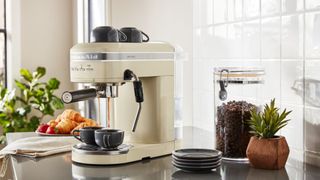
The best espresso machines will produce a perfectly balanced shot full of flavor, body and aroma. And if you enjoy drinking your cup of Joe in its purest form, you should expect a liquid that doesn’t taste bitter or burnt, with a thick layer of crema on top. Besides delivering a smooth drink, the espresso machine needs to be convenient and quick to use, with an intuitive control panel. Not to mention quiet in operation for those early morning brews. If you love to drink latte or have a taste for espresso or ristretto, this will be the best coffee maker for you.
A far cry from even the best Keurig coffee makers or best Nespresso machines, espresso machines take pure ground coffee (some even grind it themselves) and subject it to high pressure, extracting lovely, creamy espresso that can be paired with milk for a latte or cappuccino, or sipped as a morning pick-me-up.
To help you decide, we’ve selected a range of the best espresso machines. Tested at home, each machine brewed several expressos to assess speed, consistency, temperature, and, most importantly, flavor. And, if a milk frother was included, we tested this too. We also judged ease of use, considering the control panel and assess to the water tank, noise and of course, value for money. So if you want to find one suitable for your needs, lifestyle and budget, here are the best espresso machines right now.
The quick list
Here’s the best espresso machines you can buy right now based on our testing and reviews. Scroll on for our full in-depth reviews.

The Breville Bambino Plus offers the best of everything. It’s compact in design, straightforward to use and brews delicious espresso, cup-after-cup.
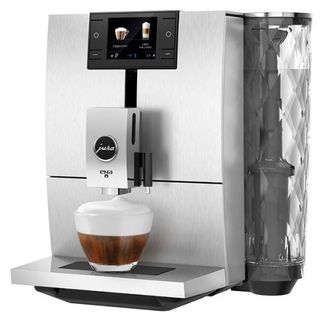
Quick and quiet, the Jura ENA8 is the best money can buy if you want a professional-level bean-to-cup from home.
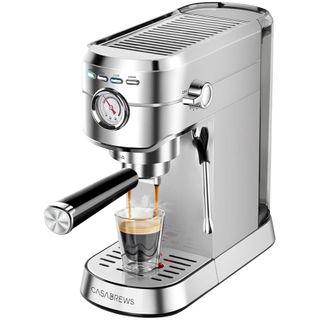
Although it lacks some of the bells and whistles we love about more premium coffee makers, the Casabrews delivers immense value for money.
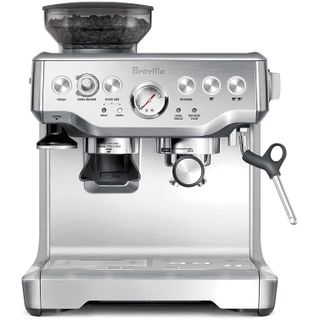
There's a reason people flock to Breville when trying to choose an espresso machine, and the Barista Express has everything we look for in a beginner barista-quality manual machine.
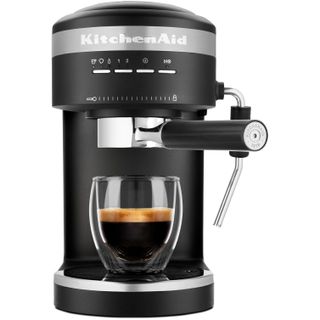
This narrow 15-bar pump espresso machine from KitchenAid looks the part and delivered Italian-standard full-flavored espresso when we put it to the test.
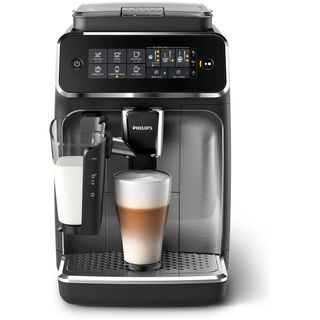
If you want a fully automatic espresso machine, the Philips 3200 Series LatteGo is our top pick. It can steam milk and brew high-quality espresso in minutes, and the LatteGo dispenser is easy to clean.
The best espresso machines you can buy today
Why you can trust Tom's Guide
The full list: Best espresso machines you can buy




Specifications
Reasons to buy
Reasons to avoid
The Breville Bambino Plus impressed us in our testing, consistently producing high quality espresso and offering an excellent automatic milk frother for that extra professional finishing touch. It's difficult to produce a bad coffee from this particular espresso machine, and with a speedy three second heat up time you'll be enjoying a fantastically brewed shot in no time at all.
Espresso
Although some will prefer to have an espresso machine with a built-in grinder, many coffee fanatics prefer to buy this separately, and choose to pair the grinder of their choice with the Bambino Plus, which produces very high-quality espresso without taking up too much counter-space.
Like many of the best espresso machines, you can adjust the espresso settings for a shorter or longer shot, however the adjustable pre-infusion settings here are particularly impressive.
Milk
We had no difficulty using this steam wand manually to create a consistent micro-foam, but what really impressed us was the MilQ Plus setting. This allows you to choose from three pre-set temperatures and textures, then leave your milk to be steamed automatically. The best bit? You'll then get to pour it yourself, allowing you to practice your latte art.
Read our full Breville / Sage Bambino Plus review.
Best luxury espresso machine



2. Jura ENA8
Our expert review:
Specifications
Reasons to buy
Reasons to avoid
Jura is the gold standard of bean-to-cup coffee machines. While some entry-level alternatives are a bit boxy, this gently curved option places user experience at the forefront. Grinding was whisper-quiet, brewing fast but considered, and the espresso was immensely high-quality considering it came from a does-it-all machine.
While the ENA8 is expensive at around $1,500 minimum, it's not out of place in the espresso machine market, and coffee fanatics will tell you that there are many more expensive options out there that offer a lot less in terms of functionality.
Grinder
Some people are nervous to embark on an espresso machine with a hidden grinder. The ENA8's grinder sits towards the back of the machine, and both the grinding and tamping process take place deep inside the machine, meaning we couldn't inspect the grounds for consistency. However, adjusting is easy enough, and we noted that the process was supremely quiet throughout.
Espresso
What sets this machine apart is the quality of its espresso. It remains the best quality espresso our Senior Home Editor Millie has tried, over a year after testing it. Each shot we poured was nuanced, bringing out the notes of any beans we threw its way. If you drink coffee for the taste, not the caffeine, you'll love this machine.
Milk
With the ENA8 you don't need to worry about grinding and tamping your beans or fiddling with grind size. It does all that for you, and while you need to buy this separately, you can also steam milk by plugging a milk container into the side of the dispenser. The micro-foam from this dispenser was sturdy yet smooth, and we liked the added touch of the lights under the dispenser switching to white when milk was being steamed.
Our only complaint is that cleaning your milk tube can be fiddly. Some alternatives automatically flush out this tube to prevent it from clogging up, but we had to rinse the residue from this manually to prevent the milk from going bad and impacting our next drink.
Best budget espresso machine




Specifications
Reasons to buy
Reasons to avoid
Considering the very reasonable price point, it's impressive off the bat that the Casabrews Espresso Machine CM5418 has a sturdy metal construction. On the front are four buttons (power, one cup, two cups, and steam), as well as a pressure gauge, and there is also a button on the side to control the steam wand or hot water dispenser. The greatest letdown in terms of quality was the portafilter, which felt a little flimsy. Still, for the price, it's hard to complain. Especially because this is something you can easily upgrade on the likes of Amazon.
Espresso
Our espresso had plenty of body and flavor. Of course, because there's no in-built grinder, you're going to want to invest in a coffee grinder if you want a really brilliant brew, as packaged coffee grounds don't dazzle the way a freshly ground bean will. Still, we were able to get a rich crema with good staying power after a few tries and with the help of the Casabrews pressure gauge.
Milk
The steam wand also lacks the bells and whistles of a more expensive machine, but was certainly capable of getting the job done. It took a little longer than most machines to pre-heat, and once it was in full flow it made quite a bit of noise, but we were able to get a good quality foam once it got going.
Read our full Casabrews Espresso Machine CM5418 review.
Best beginner espresso machine





Specifications
Reasons to buy
Reasons to avoid
If you’re a budding coffee connoisseur and customization is a top priority, we recommend the Breville Barista Express. This machine looks stunning on display with its stainless steel finish and visible pressure gauge. Not only that, it delivers too.
Grinding
We love the customization this machine allows for. You can set the coarseness of the grounds as well as the quantity to a precise degree via two separate dials. Through this, you can adjust gradually until you find your perfect settings. It’s a nice touch that the tamper is held in place via a magnet on the underside of the control panel. This keeps things tidy.
Coffee
Four portafilter baskets lets you switch between single and double shots, with single and double-walled options — should you use pre-ground coffee. On test, we found this espresso machine performed consistently, delivering a high-quality flavor and texture of espresso complete with a thick layer of crema. It’s quick to work too, although it will need 1-2 minutes to warm up at first.
Milk
The Breville Barista Express can produce lattes and cappuccinos with the use of the built-in steam wand as well. We found the milk was foamy and creamy, with a decent level of froth after steaming. Should you prefer tea, it can dispense hot water directly from here as well.
Bear in mind, this is a sizable machine, and it will take up a decent amount of counter space. We also noticed that there’s no low-water warning, which is a shame, but it’s not a deal breaker. Ultimately, if you’re happy to spend the money, and you want an espresso machine that looks as good as it performs, this is the one to get.
Read our full Breville Barista Express review.
Best smart espresso machine



Specifications
Reasons to buy
Reasons to avoid
Thanks to its smarts, the TK-02 is the coffee machine for everyone. The built-in touchscreen lets you touch a drink from the menu and automatically starts brewing. This eliminates the most tedious parts of creating flavorful coffee, so anyone can quickly order up or create a delicious drink and go about their day. Enthusiasts willing to forego manual controls can dive deep into the digital settings to adjust dosage, pressure, brew temperatures, and more.
It’s not the cheapest machine out there, but it's a worthy investment if you value both aesthetics and performance—and you’re tired of dealing with manual controls and pods. Not only can you schedule it to wake up to cafe-quality specialty coffee without lifting a finger, but the machine even shows you how much money you save with each cup. This pulls a perfect shot every time. It has several settings, including an exclusive drip coffee that tastes absolutely fantastic in the iced coffee setting. You can use the app or built-in touchscreen to customize your selection by strength, size, and the amount of steamed milk.
Coffee
When we tried it out for ourselves, we found the coffee roasted evenly without getting too acidic or punchy for our pallet—even at stronger settings. It will surely give you a kick when set to its finest grind setting but overall you can extract a wide range of flavors from the same bag of beans.
Milk
Outside of the baseline setting the milk foam quality is either a bit too thin or thick. The attachments are easy enough to setup and use, but removing the hose and cleaning it can get old fast due to the extra care the removal process needs.
Read our full TK-02 Connected Super Automatic Espresso Machine review.
Best compact espresso machine




Specifications
Reasons to buy
Reasons to avoid
The sleek and glamorous look of the KitchenAid Semi-Automatic Espresso Machine means it will suit any modern kitchen. It features a compact design and at 15 lbs it’s easy enough to move around.
Our only real qualm with this espresso machine is that an aptly sized espresso cup can easily vibrate out of place when pouring. You either need to hold it in place (not ideal from a safety perspective), or use a larger, heavier cup to avoid this issue. Other than that, we loved the design of the KitchenAid Semi-Automatic Espresso Machine. It gives you the opportunity to be more involved in the espresso-making process, including measuring out and tamping down the ground coffee yourself. Bear in mind it comes with a plastic exterior though, which might not be what you expect from this brand.
Coffee
When we put it to the test, we found it produced nothing but delicious espresso from ground coffee, complete with a thick layer of crema and a delectable aroma. It couldn’t be more straightforward to operate either, with four buttons to control everything, from the size of the shot, to the water hardness level and temperature. There’s a useful clean cycle here to help with descaling as well.
Milk
This espresso machine offers some basic functions in addition to pouring espresso — it can produce steam and boiling water via the steam wand, meaning it can froth milk as well as pour water for hot tea. It was more than adequate in both of these areas, although we thought the steaming lacked a little power compared to the market-leaders, so it could take a bit longer to get the consistency you're looking for.
Read our full KitchenAid Semi-Automatic Espresso Machine review.
Best fully automatic espresso machine




Specifications
Reasons to buy
Reasons to avoid
The Philips 3200 Series doesn’t come cheap, but it brings a lot to the table. This espresso machine lets the user create beverages which would usually require barista-level experience at the push of a button. It comes with several settings, including espresso, hot water, cappuccino, coffee, latte macchiato and americano. Plus there’s the option to customize your selection by strength, size and the amount of steamed milk.
Coffee
When we tried it out for ourselves, we found the coffee it produced tasted good and was not overly bitter. While we were generally pleased with the results, it could have tasted stronger. This was even the case when we adjusted it to its finest grind setting. The quality of the crema was on the thin-side too. For this reason we wouldn’t recommend this machine to anyone who likes their coffee to pack a punch.
Milk
We found similar results after steaming milk as well — while it held its form, it wasn’t as dense as it could have been. However, while the overall performance was somewhat average, operation couldn’t be much more straightforward. And with the attachments being easy to remove and clean (the LatteGo parts can even go in the dishwasher), it’s a nice offering if you value simplicity above all.
Read our full Philips 3200 Series Fully Automatic Espresso Machine w/ LatteGo review.
How we tested the best espresso machines
We tested every espresso machine for ourselves, factoring in different types and styles to suit different circumstances. We brewed a selection of beverages, considering the speed and efficiency of the process and the flavor of the result. We also made a note of any strengths and weaknesses of the model, including the effectiveness of the milk frother and the ease of filling and emptying the grounds. As a result, we can say with confidence that that this list accurately reflects the performance of each machine. These are the best espresso machines you will find.
Which type of coffee maker should you buy? Check out our guide if you're unsure. We've also tested the best travel coffee mugs, if you're looking for a to-go cup.
| Row 0 - Cell 0 | Type | Settings | Water capacity (oz) | Pressure (bar pump) | Milk frother | Grinder | Accessories |
| Breville Bambino Plus | Espresso machine (ground) | 1 or 2 cups and steam | 64 | 15 | Yes | No | Tamper, trimming tool, milk pitcher and cleaning tools |
| Jura ENA8 | Espresso (bean to cup) | Espresso, Cordado, Coffee, Cappuccino, Flat White, Latte Macchiatto, 2x Espresso, 2x Coffee, Milk Foam, Cappuccino Extra Shot, Flat White Extra Shot, Latte Macchiato Extra Shot, Espresso Doppio, Caffe Barista, Hot Water | 37 | 15 | Sold Separately | Yes | Water filter |
| Breville Barista Express | Espresso machine (bean or ground) | 1 or 2 cups, hot water and steam | 67 | 15 | Yes | Yes | Tamper, trimming tool, milk pitcher, cleaning tools |
| KitchenAid Semi-Automatic Espresso Machine | Espresso machine (ground) | Single/Double espresso, hot water and steam | 50.7 | 15 | Yes | No | Milk pitcher, coffee scoop and tamper |
| Philips 3200 Series LatteGo | Espresso machine (bean or ground) | Espresso, coffee, latte, Americano and hot water | 61 | 15 | Yes | Yes | Scoop and water filter |
How to choose the best espresso machine
Selecting the best espresso machines for you comes down to 3 considerations: how much space you have in your kitchen, the size of your budget, and how much work you want to put into the brewing process.
Below we describe the four types of machines so you can decide which is best for you.
Manual: These handsome and expensive machines have a lever that you pull to deliver a shot of espresso. With a manual espresso maker, you have complete control and can produce your ideal cup but also have the best chance of messing up. We think that they’re best left to professionals or serious coffee connoisseurs.
Semiautomatic: This type, which has an electric pump is the most popular. It allows you to do the grinding and tamping yourself but the motor gives consistent flow and pressure. You control the quantity of espresso in your cup by stopping the extraction process. Most semiautomatics have a steam wand or other mechanism for heating and frothing milk and some have a built-in grinder as well. Those without a grinder are generally the most compact and least expensive. You can find a good machine in this category for under $500.
Fully Automatic: With a fully automatic espresso maker, even the amount of water is determined by the machine. All you have to do is fill it with beans and press a button and the machine delivers your drink of choice whether it’s an espresso or a latte macchiato. Many do give you the opportunity to customize the grind, the temperature, the strength, and/or the amount to your liking. Virtually all feature steamers and burr grinders. Because they have so many features these machines will take up the most space in your kitchen and come with the highest price tags.
Capsule: The machines provide the ultimate convenience. You pop a capsule in, press a button and you get a cup of espresso topped with a layer of crema. The only thing you have to do is keep a supply of coffee capsules on hand and fill the tank with water. Choose from a variety of configurations and models with and without on-board frothers or steaming wands. Capsule espresso makers aren’t cheap but won’t set you back as much as a fully automatic model.
Other features to consider
In shopping for an espresso maker, you’ll also hear a lot about Bar Pump Pressure. An espresso machine requires pressure to extract flavor from finely ground coffee. The pressure in pump machines is measured in bars or units of atmospheric pressure. Although 8 to 9 bars is considered sufficient, most machines, including all of our best espresso machines, have at least 15-bar pumps.
In addition to the built-in conveniences mentioned above, like burr grinders and steam wands, many espresso machines also come with some added accessories, like scoops and tampers to get your measurements just right. All of these extras and more are highlighted in our selections above.
Espresso machine FAQs
Is an espresso machine worth it?
If you want the freedom to experiment with nearly everything about your coffee's brewing process, an espresso machine is absolutely worth it. Even if you're a beginner looking to produce cafe-style drinks from the comfort of your own kitchen, there's plenty of value in an all-in-one home setup. These days, the best espresso machines pack a wide range of features but also cater to varying skill levels, so you can gradually grow more confident in experimenting over time.
If, however, you just want a simple cup of coffee and don't have time to grind your own beans, fill your brew basket, tamp, pre-infuse, and froth your milk, then it might be worth sticking with a drip machine or pod coffee maker. There is a little extra effort involved when brewing from an espresso machine, not including the sometimes fiddly cleaning schedule.
How do you maintain an espresso machine?
To ensure that your espresso machine functions well for as long as possible, it must be regularly maintained and kept clean. There are a few main areas to look for:
Water reservoir
Over time, minerals and sediments can build up inside the water tubes in your espresso machine, which will lessen the amount of water that can get though. It's important to know how to descale a coffee maker to remove this buildup.
Drip tray
Most espresso machines will have a drip tray that catches excess water and coffee grounds. You should clean this out regularly to avoid bacteria from growing in the water.
Milk foamer/frother
If you make a lot of lattes or cappuccinos, chances are you're using the steam function on your espresso machine. You should wipe this clean after each use to prevent milk residue from accumulating and hardening.
Used coffee grounds
Some espresso machines will deposit used coffee grounds in an internal storage area, while others will require you to dispose of the grounds after each use. Instead of throwing the grounds in the trash, use them in your garden: they're great for composting.
When should you replace an espresso machine?
The best espresso machines typically come with a one or two year warranty and stay in operation anywhere from 7 to 10 years. As you would expect, an expensive fully automatic model will last the longest. When you buy a machine, don’t spring for an extended warranty. It’s unlikely that it will cost less than repairing your machine during its lifetime.
Among the things you’ll notice when your machine breaks down is that stops building up pressure or your espresso doesn’t come out as hot as it used to. These problems could be indicative of a faulty pump or heating element that isn’t worth fixing. If you bring it in for a repair and are quoted a price that is over 50% of the cost of a new unit, we recommend buying a replacement. To keep your machine in good working order as long as possible, be sure to clean your coffee maker thoroughly. Defer to the instruction manual for this, as well as information on regular maintenance on a daily, monthly, and yearly basis.
When you buy a new espresso machine, you’ll also find features available that aren’t offered on older models. Electronic displays, hot water spouts, and frothed milk dispensers are now common. Steam wands have been improved so that they are easier to use and give better foaming. Whether you like the convenience of premeasured pods of coffee or want a machine that grinds beans for each dose of coffee, you can now find more machines to meet your needs.
Wi-Fi and Bluetooth connectivity are still rarely available on espresso machines with the exception of smart coffeemakers from Nespresso. They allow you to control the machine and get alerts when you’re running low on capsules on an app on your mobile device.
Sign up to get the BEST of Tom's Guide direct to your inbox.
Get instant access to breaking news, the hottest reviews, great deals and helpful tips.

Millie is the Senior Home Editor at Tom's Guide. She's been reviewing home tech for over five years, testing everything from coffee makers to the latest vacuum cleaners. Starting out in 2019 as a Staff Writer at TopTenReviews, Millie then moved on to Future's Homes portfolio, where she eventually oversaw all product testing as Head of Reviews.
With particular expertise in cookware and kitchen appliances, you'll struggle to find an air fryer Millie's not tested. She's traveled the world reporting on the latest home innovations and product launches, learning how to use pizza ovens from Pizzaiolos in Naples, and touring the De'Longhi factory in Venice.
When she's not reporting on home and appliance trends, Millie loves watching live music. She's currently learning the guitar - naturally, she plays a Fender.
-
Wisdawn Thank you for this guide but I think that there's a serious drawback to the approach of the review itself here, and that is it completely ignores the espresso machine's microfoam-milk capabilities. This could be because the reviewer(s) are connoisseurs who enjoy straight espresso rather than white coffee, or for some other reason. And I, for example, enjoy straight espresso but I also like to entertain family or guests -- even myself -- with a good latte or cappuccino sometimes, and I've learned that the pressure must be good enough and the spout must look a certain way, like a professional espresso machine's spout, just a stainless steel thin pipe, to be able to produce milk with microfoam. I would be very interested in reading another espresso-machine review from Tom's Guide, which includes the microfoam-milk capabilities of all the espresso machines and sorts them also by the relevant order. I'm interested in knowing, for example, the cheapest espresso machine out there today that has true manual microfoam-milk capabilities, in the right hands, of course. And thanks again.Reply -
Rob In Boston Regarding the Breville Oracle Touch. It makes amazing coffee but it is amazingly fragile for a machine at this price point. I've had mine for 2 years and I've had to send it back 4 times for repairs and/or replacement. I would never recommend this machine.Reply -
TomGuided An article that says you can make good espresso from a Nespresso machine is not well informed. And not even mentioning the grinder is a huge mistake.Reply
Good espresso requires three things only:
Freshly-roasted coffee (4 to 21 days from roast date), which is correctly ground right before making the espresso. No cafe anywhere pre-grinds espresso.
Clean water
Nine bars of pressure at 197-201 degrees F
The review doesn’t even mention grinding, which is more important than the espresso maker. There’s no paper filter with espresso; the coffee itself is the filter and it needs to be very finely and consistently ground for a good espresso. It’s the consistency part that makes a good grinder so critical. At a minimum, get a Baratza Sette 270 grinder, or for faster work, their 270w, which precisely weighs each dose. There is a family of grinders called DF64 which are even better.
As for the machine, the newest Breville Bambino is excellent, or, ideally, the Breville Dual Boiler (not the Oracle) is fantastic. Paired with a good grinder, fresh espresso beans and a scale, and your espresso can rival (and usually beat) any cafe. The Dual Boiler model will do a better job, especially at milk steaming.
Workflow takes time to learn, and goes something like this:
Weight 17 grams of beans
Grind them
Distribute and tamp them into the portafilter
Put your cup on a scale and make the shot
Aim for 17 x 2, or 34 grams of espresso, delivered in 25 to 30 seconds
If you get 34 grams in less than 25 seconds, make the grind setting finer
If you get 34 grams in more than 30 seconds, make your grind setting coarser
Once you land in the 34g in 25-30s zone, your beans are “dialed in,” although you can now adjust to taste from this reference.
Steam milk, pour a beautiful swan or flower design, and drink.